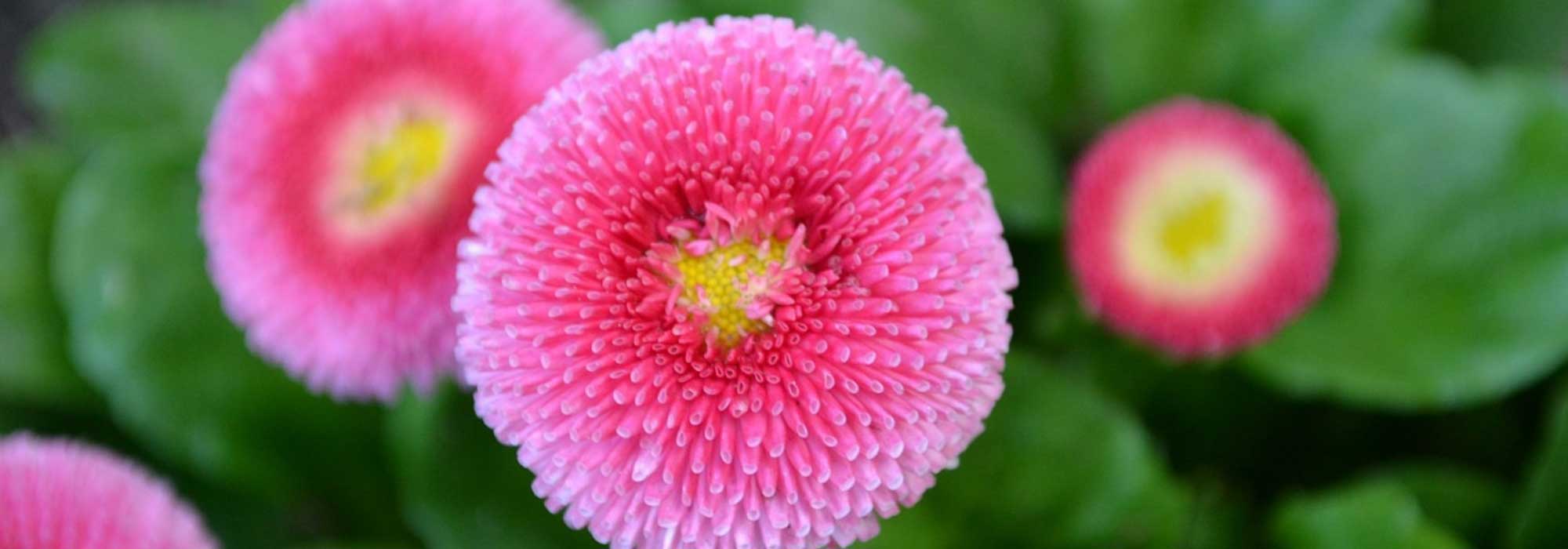
Daisy, bellis perennis: planting, sowing and growing
Contents
Daisy in a nutshell
- Single or double daisy flowers, white to pink and somewhat naïve, herald the arrival of spring
- Its long flowering period with soft or vibrant colours is a delight as winter fades and before the summer heat
- Perfectly hardy down to -15°C, it is grown as a biennial since its lifespan does not exceed 2 years
- It is a short-lived perennial that is very easy to cultivate, thriving in any good well-drained garden soil and in sunny or shaded positions, requiring no maintenance
- It finds its place almost everywhere in our gardens, dotting our short grass meadows, brightening paths, borders, flower beds, or spring containers
A word from our expert
With its flowers that are both cheerful and discreet, the Daisy, also known as Bellis perennis, brightens up the garden as spring arrives.
Bellis perennis, the common daisy has given rise to numerous varieties of daisies, mainly with double flowers, which are more sophisticated than this little daisy that gracefully sometimes invades our short grass meadows and meadows.
From pink daisies to yellow or even red ones, its many small flowers, whether single or in lovely pom-poms, display pure, pastel, or more striking colours in turn.
Early and vigorous, it is not afraid of the cold and is grown as a biennial requiring little maintenance: the long and generous flowering of the daisy will delight beginner gardeners!
You can even consume it in salads as the daisy is edible. A true delight for the eyes and the body that would be a shame to miss out on!
Let yourself be charmed by its childlike appeal and don’t resist the urge to plant our daisies in plug plants or to sow our daisy seeds among the spring bulbs at the foot of the flower beds or in containers!
Description and Botany
Botanical data
- Latin name Bellis perennis
- Family Asteraceae
- Common name Daisy, Easter Flower
- Flowering from February to August
- Height 0.5 to 0.20 m
- Exposure sun or partial shade
- Soil type All, well-drained
- Hardiness -15°C
Daisy, sometimes called “Little Daisy” or “Easter Flower”, although it blooms as early as the end of winter and sometimes until the onset of autumn, is part of the Asteraceae family like its cousin the daisy.
It grows spontaneously in meadows, on lawns, prairies or mountains of Europe and Turkey, sometimes up to 2,200 m in altitude.
The genus Bellis includes about fifteen species of perennials, including the wild species Bellis perennis, considered an undesirable plant in ornamental gardens that has given rise to numerous cultivars mainly with double flowers, more sophisticated than this meadow daisy. Less hardy than the type species, they tend to be less floriferous after two years of cultivation, for this reason they are grown as biennials, meaning they only bloom the year following their planting.
However, the daisy should not be confused with Erigeron or Fleabane, also known as “wall daisy”, another Asteraceae, which belongs to a different genus.
The many varieties of daisies are classified into series, according to the shape and size of their flowers, from single to very double: ‘Pomponnette’ with very double heads, ‘Habanera’ with giant well-double flowers, ‘Tasso’ with pompons of tubular petals or even the series ‘Radar’ with large well-double flowers, sometimes dishevelled.
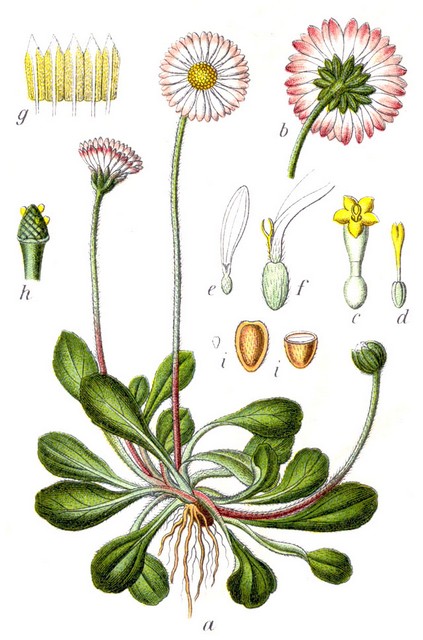
Bellis perennis – botanical illustration
The daisy spreads quickly, by emitting stolons, which root in place to form in turn biennial rosettes in the lawns of our gardens.
It produces rosettes of evergreen leaves with a more or less stout habit. Lanceolate, ovate to spatulate, the leaves measure from 1 to 6 cm long. Dark green, they are sometimes slightly downy.
The Daisy is appreciated for its long flowering, both light, simple and colourful.
From the end of winter, from February until September sometimes, the inflorescences in the shape of daisies emerge from this mass of small leaves, borne by rigid pubescent stems from 5 to sometimes 18 cm above the foliage (the ‘Robella’ is the tallest daisy!). Each hairy petiole bears at its end a flower in a small solitary head.
Herald of the long-awaited spring, the daisy flower with its innocent charm then settles in for a long season.
If the type species Bellis perennis, the common daisy of our prairies, has thin flat white ligules, tinged with purplish pink on the reverse, the cultivars are characterised by forms that are both simple but more impressive in flashy pompons with a very double heart, like ‘Pomponnette’, double to semi-double for the type with large flowers.
It consists of an infinity of florets positioned with geometric regularity. Depending on the cultivars, these heads take on sometimes dishevelled appearances with their long tapered petals, sometimes more compact and well-rounded with tubular petals like the daisies from the ‘Pomponnette’ and ‘Tasso’ series.
Often globular and sometimes slightly flattened, these characteristic flowers are made up of numerous very fine petals, sometimes so tightly packed that they barely reveal a small golden heart. While the smallest measure only 2 cm, the ‘Habanera’ Daisies bear the largest flowers (6 cm in diameter) and are often referred to as “monstrous flowers”.
These small balls, most of the time almost complete, come in candy colours ranging from carmine pink to very deep red, passing through a unique salmon pink and pure white. Some cultivars have variegated or bicoloured flowering.
These small melliferous pompons renew themselves continuously throughout spring and well beyond, attracting the flight of pollinators, bumblebees, bees and butterflies, sometimes until the onset of winter if faded flowers are regularly removed; a beautiful generosity that has undoubtedly earned Bellis perennis its Latin name of “eternal beauty.”
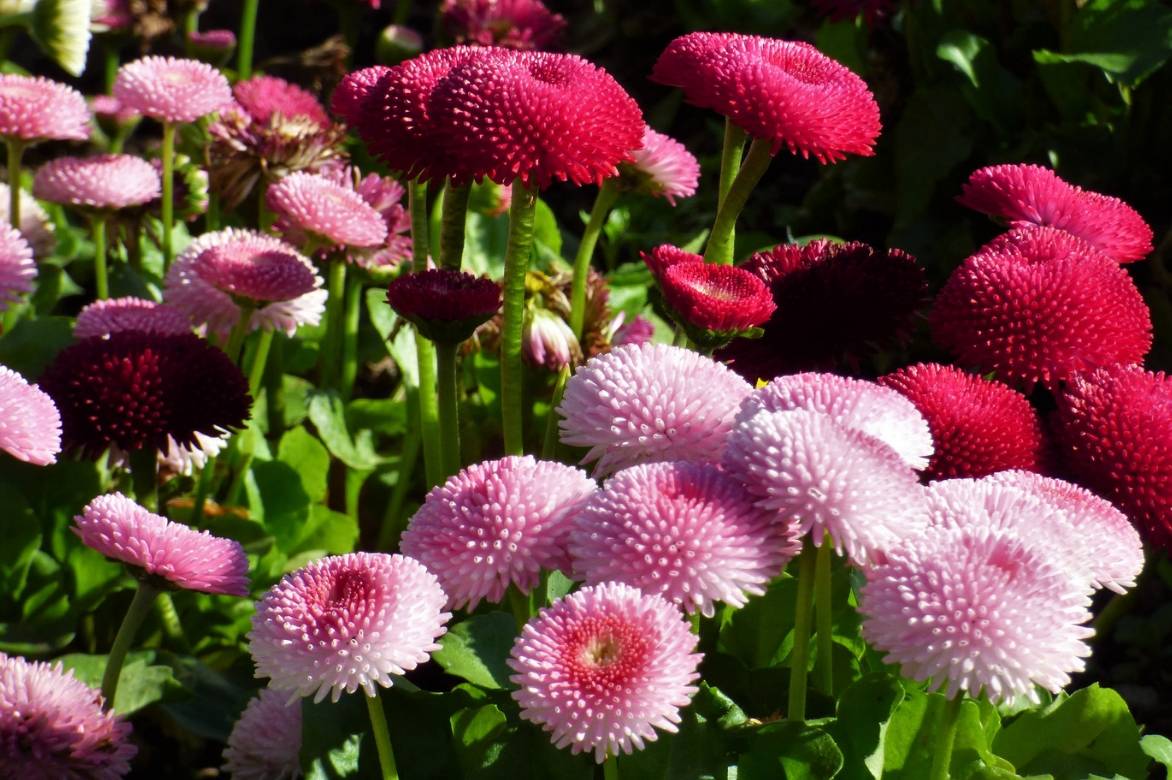
(photo Mark Coleman-Flickr)
Compose pretty bouquets of daisies to bring a rustic and fresh touch to your home. The petals of the daisy are edible and will colour your first salads, its leaves can be cooked in puree while the flower buds will be candied like capers.
The Daisy withstands the cold well. Hardy down to -15°C, it is grown as a biennial because its flowers degenerate in two seasons. Not demanding on soil type, it prefers however a good compact garden soil, well-drained, not too dry, rich in organic matter. Reserve a spot for it in the sun or partial shade, the daisy is content with little.
The Daisy is used as a border or in carpets with other spring flowers and adds a lot of charm to balcony boxes or at the foot of flower beds near early bulbs.
The wild Daisy or Bellis perennis is a small medicinal plant used in homeopathy in herbal tea or essential oil for its diuretic, healing and anti-inflammatory properties and also in cosmetics for its firming properties.
Read also
Plant biennials in plug plantsMain species and varieties
There are numerous cultivars derived from Bellis perennis (the common daisy), with simple flowers but most often very double, in the shape of well-rounded pompons. They are classified into series according to the size and shape of their more or less large and double flowers: Daisy ‘Pomponnette’, ‘Habanera’, ‘Tasso’, or ‘Radar’.
Less hardy than the type species, all these horticultural varieties are grown as biennial plants.
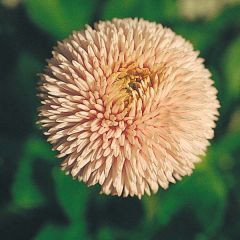
Robella Mini-motte Daisy - Bellis Perennis
- Flowering time March to June
- Height at maturity 15 cm

Bellis perennis Habanera - Common Daisy
- Flowering time March to June
- Height at maturity 15 cm

Bellis perennis Pomponette Mixed - English Daisy Seeds
- Flowering time April to June
- Height at maturity 15 cm
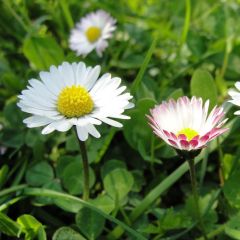
Bellis perennis - Common Daisy Seeds
- Flowering time April to June
- Height at maturity 10 cm
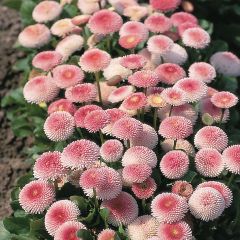
Bellis perennis Tasso Strawberries & Cream - Common Daisy
- Flowering time March to June
- Height at maturity 15 cm
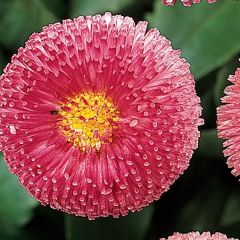
Bellis perennis Tasso Rose - Common Daisy
- Flowering time March to June
- Height at maturity 15 cm

Bellis perennis Tasso Blanche - Common Daisy
- Flowering time March to June
- Height at maturity 15 cm
Discover other Daisies
View all →Available in 2 sizes
Available in 2 sizes
Available in 4 sizes
Available in 1 sizes
Available in 1 sizes
Available in 1 sizes
Available in 1 sizes
Available in 2 sizes
Available in 1 sizes
Available in 1 sizes
Planting
Where to plant the Daisy or Bellis perennis
Very easy to grow, with good hardiness (-15°C in well-drained soil), the Daisy is not afraid of frost, grows everywhere in France and adapts to all climates. Once well-rooted, the wild species Bellis perennis can self-seed spontaneously. It naturalises very easily in sunny areas of the garden and can even become invasive if the soil suits it, colonising large areas.
Although they are perennials and hardy, its cultivars are grown as biennials, as flowering diminishes from the second year.
It tolerates partial shade in warm regions, but will thrive better in full sun.
Not very demanding regarding soil type, it will be satisfied with any ordinary soil but will reach its full potential in well-drained yet compact soil, rather cool, rich in organic matter, to ensure good flowering.
Its size allows it to fit in the front of borders as well as in pots and window boxes, along a path or even in rockeries where it will intermingle with spring bulbs such as muscaris, daffodils, or hyacinths. It will form a perfect ground cover when planted in a flowering meadow or as a colourful carpet at the foot of roses or spring-flowering shrubs.
When to plant the Daisy or Bellis perennis
The planting of our daisies in plug plants should be done as soon as received, preferably in autumn, from September to October, even until November, avoiding periods of frost and drought.
How to plant the Daisy
In open ground
Plant it in large groups or in small touches among other bulbous plants or spring-flowering perennials that are smaller. Space the plants 15 cm apart and count 9 to 12 plants per m².
- Soak the plug plant in a bucket of water before planting if it is not moist enough
- Dig the soil well to a spade’s depth
- Remove roots of weeds and stones
- Using a trowel, dig holes the size of the plug
- Encircle the plug with soil, adding a bit of well-matured compost
- Firm the soil
- Water lightly
In pots
The daisies thrive in window boxes, pots, or hanging baskets: the substrate must be rich and well-draining.
- At the bottom of the container, spread a good layer of drainage (gravel or clay balls)
- Plant the plug plants in a mix of 50% garden soil and 50% good potting soil
- Add a handful of compost
- Water very regularly, never allowing the substrate to dry out, as this is the guarantee of prolonged flowering!
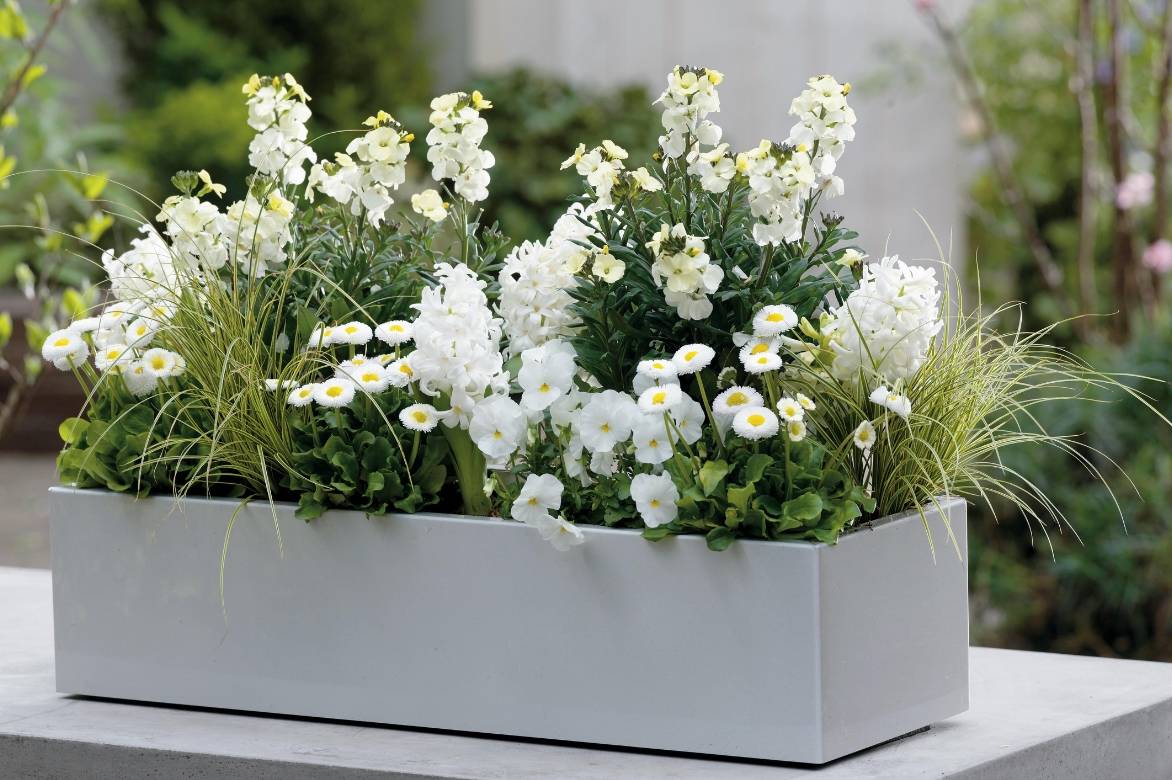
A lovely window box made of double daisies (‘Tasso Blanche’), wallflowers, hyacinths (‘Madame Sophie’), pansies (‘Matrix White’) and small Carex oshimensis ‘Evercream’ (©Friedrich-Strauss-Biosphoto)
When and how to sow Daisy seeds
The Daisy seeds are sown in summer, in May, June or July for transplanting the young plants in September or October or the following spring.
In open ground
Daisy seeds need temperatures to be well warmed, between 15 and 20 °C, to be sown outdoors, wait until June.
- Loosen the soil well and remove stones and roots
- Sow by scattering the seeds evenly, without crowding them too much
- Cover with a few millimetres of potting soil
- Lightly firm down with the back of a rake
- Water with a fine spray
- Thin out to keep one plant every 20 cm in all directions
In trays
- In a properly ventilated shelter, sow by scattering in a tray or in buckets filled with potting soil mixed with a bit of sand on a draining layer of gravel
- Cover the seeds with a bit of potting soil and lightly firm down
- Keep it moist in the warmth
- Germination occurs between 7 and 21 days
- Thin out a few plants at germination
- In October, when the young plants have strengthened, transplant them into beds spacing the plants 20 cm apart in all directions or into window boxes
Maintenance and care
The maintenance of the Daisy is minimal. Once well established in the sun and well-drained soil, it manages on its own.
In the first spring and summer following planting, water regularly, especially during dry periods, but do not flood it: the root should remain moist but not waterlogged. A rather fertile soil encourages flowering: in spring, add some compost at the base.
In pots, provide a liquid fertiliser for flowering plants every 15 days.
Encourage the appearance of new flowers by removing faded flowers; this will also prevent unwanted self-seeding.
Pull up and renew the plants every 2 to 3 years as they will become less floriferous, with flowers tending to degenerate beyond two seasons.
To maintain the small meadow daisy in your short grass meadow: mow high enough (10 cm).
You can also harvest daisy flowers throughout the flowering period: cut them, wash them, and let them dry in a dry, airy place. You can consume these dried flower heads as herbal tea.
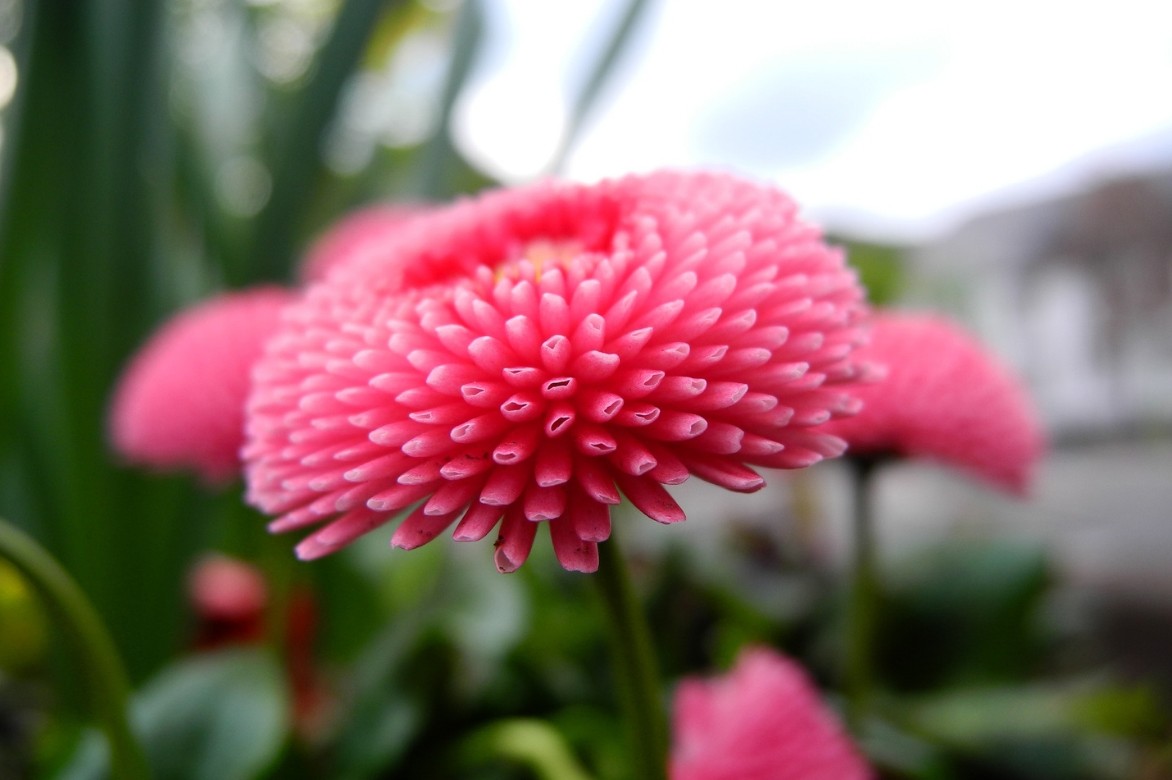
Bellis perennis Tasso Rose
Diseases and potential pests
As early as February, when the first daisies appear: protect them from the appetite of slugs: use manure of ferns to combat their attacks or spread a band of ash around the plants. Discover the different ways to fight slugs effectively and naturally.
Multiplication
Dividing clumps is not recommended, as it exhausts the plants. The type species, Bellis perennis, self-seeds and tends to become very quickly invasive. Only its less expansive cultivars are suitable for propagation: proceed with sowing in summer (see our tips for sowing daisy seeds above).
Associating
With their simple flowers, both cheerful and discreet, the Daisy is ideal for a wild garden, in a naturalistic meadow, even rivaling the herb.
There are plenty of spots in the garden to place these little spring scouts to create rose-inspired scenes full of tenderness and softness.

A spring pairing idea: Bellis perennis ‘Tasso Strawberries & Cream’, Myosotis and Muscari aucherii ‘White Magic’
They are among the first flowers of spring to show their faces and accompany the spring bulbs in fresh compositions, such as daffodils, narcissi, muscari, crocuses, hyacinths, or myosotis.
In borders and beds, they will be surrounded by heucheras, bulbous plants, and other annual or biennial flowers such as tulips, Fritillaries, and wallflowers, in a harmony of deeper tones.
In pots and window boxes, they will be the perfect companions for pansies and violets in pastel shades or alyssum.
Useful resources
- The daisy mixed with early bulbs marks the awakening of spring!
- Discover our unique collections of annuals or biennials
- Create a happy garden with daisies in the most vibrant colours
- Subscribe!
- Contents
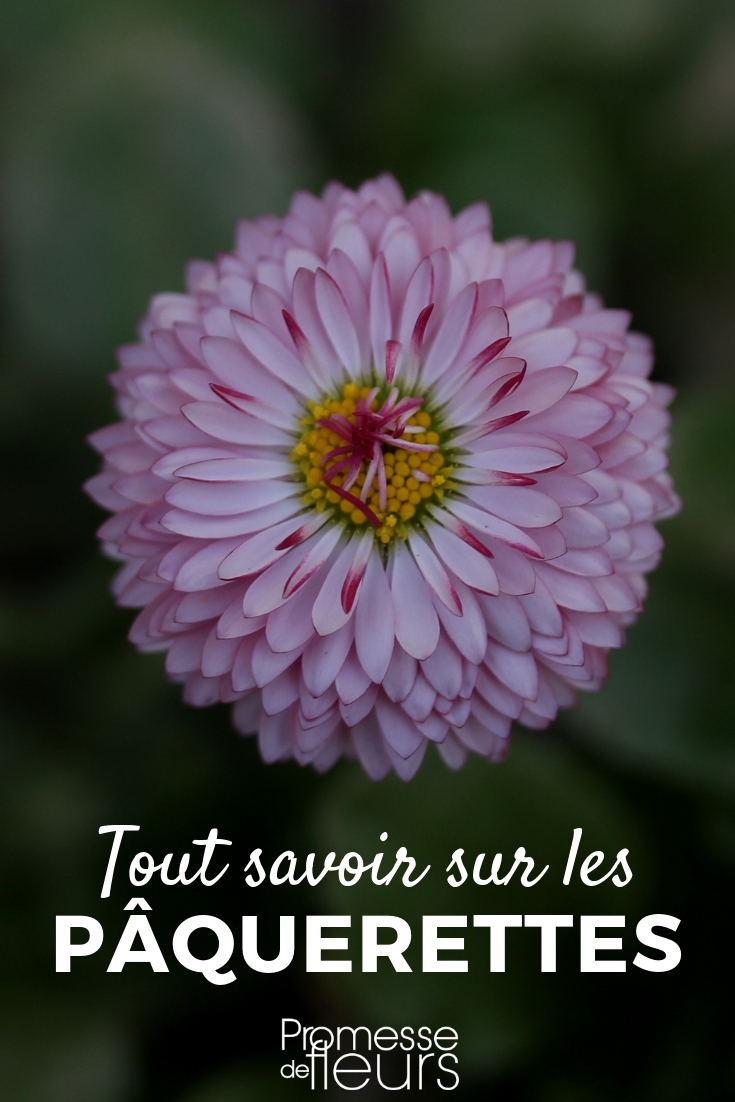
































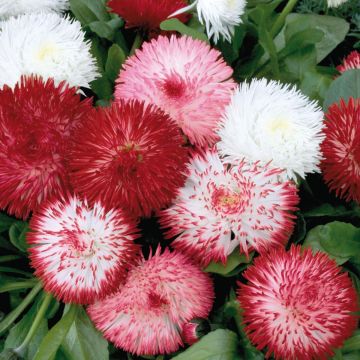

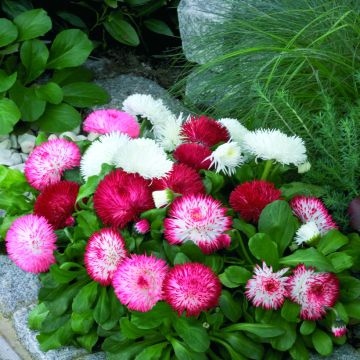
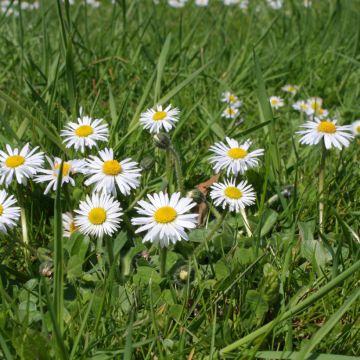

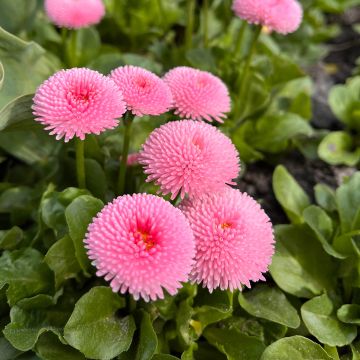

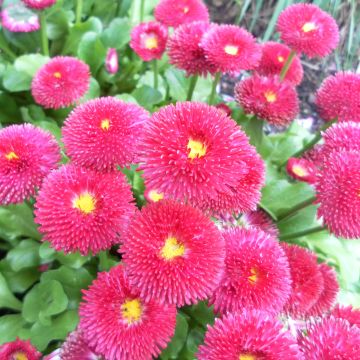

Comments